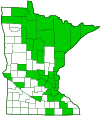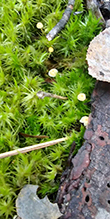broom forkmoss
(Dicranum scoparium)
Conservation • Description • Habitat • Ecology • Use • Distribution • Taxonomy
|
|
||||||||||||||
Description |
Broom forkmoss is a common, widespread, perennial, tuft-forming moss. It occurs throughout the Northern Hemisphere and in Australia and New Zealand. In the United States it occurs east of the Great Plains, west of the Rocky Mountains, in the northwest, and in Colorado. It is common in Minnesota. It is found mostly in deciduous forests and mixed forests but also sometimes in coniferous swamps, in bogs, and in fens. It appears on the ground on soil, humus, woody debris, decaying stumps and logs, tree bases, or rock with a layer of soil on it. It grows under full or medium shade, in wet to moderately dry soil. Broom forkmoss has an upright growth form (acrocarpous). It is highly variable, the most variable of all forkmoss species. It forms dense to loose, light green to dark green, small to medium-sized tufts. The tufts are usually moderately shiny, sometimes dull. The stems are erect to ascending, unbranched, and ¾″ to 4″ (2 to 10 cm) tall. They are anchored to the substrate by a dense mat of reddish-brown to occasionally white fibrous filaments (rhizoids). The stem surface has a dense, woolly covering of fine, white to reddish-brown rhizoids providing moisture retention. The stem is densely covered with overlapping whorls of erect to ascending leaves. The leaves are mostly curved and aligned in the same direction, appearing wind swept or broom-like. They are ⅛″ to 5⁄16″ (4 to 8.5 mm) long, sometimes longer, and 1⁄32″ to 1⁄16″ (0.8 to 1.8 mm) wide. The leaf blades are lance shaped, ridged (keeled) above, and narrowly to somewhat broadly angled at the tip. The midvein (costa) may reach the leaf tip (percurrent), extend beyond the tip in a hair-like extension (excurrent), or end before the leaf tip. It is one-tenth to one-fifth the width of the leaf at the base and usually has 2 ridges above. The leaf margins are strongly but minutely toothed on the outer third. The ridges on the costa and the teeth on the margin both require a 20x hand lens to see. Male and female reproductive organs appear on separate plants within the same tuft. Male plants may be the same size as female plants or be dwarf plants growing on rhizoids of female plants. Single female reproductive organs (sporophytes) are sometimes produced but are not common. The sporophyte consists of a spore-bearing capsule at the end of a slender, yellowish-brown to reddish-brown, more or less erect, ¾″ to 1 9⁄16″ (2 to 4 cm) long stalk (seta). The capsule is 1 ⁄16″ to ⅛″ (2.5 to 4.0 mm) long, cylinder-shaped, strongly curved, and inclined to the horizontal. It has an opening at the end through which spores are eventually dispersed. The opening is covered with a membranous hood (operculum). When immature, the capsule is light green and is mostly covered by a large, smooth cap (calyptra). The calyptra has an extension at the end (beak) as long or longer than the capsule. As it matures, the capsule develops a ring around the opening (annulus). When mature, the capsule is yellowish-brown to reddish-brown. The annulus is large and rolled back. It eventually forces the operculum and calyptra to drop off exposing the capsule opening. Around the opening there is a single set of 16 reddish-brown teeth. The capsule becomes furrowed with age. Spores are dispersed late spring to mid-summer. Plants in bogs and other extremely wet habitats have a different appearance. The leaves are straight and erect. Sometimes there are shoots at the tip of the stem with shorter, broader leaves. |
Growth Form |
Acrocarp |
Height |
¾″ to 4″ (2 to 10 cm) |
Similar Species |
Habitat |
Deciduous and mixed forests, coniferous swamps, bogs, and fens |
Ecology |
|
Use |
|
Distribution |
||
|
Sources Janssens, J.A. 2014. Noteworthy Mosses & Liverworts of Minnesota, Part II: Species Fact Sheets. Minnesota Department of Natural Resources 2014, 208 pp. |
|
| 4/29/2024 | ||
Nativity |
||
Native |
||
Occurrence |
||
Very common and very widespread |
||
Taxonomy |
|
Kingdom |
|
Division |
|
Subdivision |
Bryophytina (Moss) |
Class |
Bryopsida (Joint-toothed Mosses) |
Subclass |
Dicranidae |
Order |
Dicranales |
Family |
Dicranaceae (broom mosses) |
Genus |
Dicranum (forkmosses) |
Subordinate Taxa |
|
|
|
Synonyms |
|
Dicranum latifolium |
|
Common Names |
|
broom forkmoss broom fork-moss common broom moss dicranium moss windswept broom moss |
|
Glossary
Acrocarp
A moss that grows in cushions or tufts; has an upright growth habit; is usually unbranched or sparingly forked; and has the female sporophytes borne at the tips of stems and branches. Adj.: acrocarpous.
Annulus
On mosses: a ring of cells around the capsule opening beneath the operculum.
Beak
In plants: A comparatively short and stout, narrow or prolonged tip on a thickened organ, as on some fruits and seeds. In insects: The protruding, tubular mouthpart of a sucking insect.
Calyptra
On mosses: A thin cap that covers and protects the capsule and operculum and drops off at maturity.
Costa
On ferns: The central axis of a pinna, to which pinnules are attached. On mosses: the central axis (midvein) of a leaf. On insects: The vein on the leading edge of the forewing.
Keeled
Folded, as in a grass blade, or with a raised ridge, as in a grass sheath; like the keel of a boat.
Operculum
On mosses: A lid or cover that covers the opening of a capsule and detatches at maturity. On snails: The horny or calcareous door-like structure that seals opening of the shell. On fishes: A bony flap on the rear side of the head that protects the gills.
Rhizoid
A filament arising from the lower stem of a moss, liverwort, or alga that anchors it to a substrate.
Seta
A stiff, hair-like process on the outer surface of an organism. In Lepidoptera: A usually rigid bristle- or hair-like outgrowth used to sense touch. In mosses: The stalk supporting a spore-bearing capsule and supplying it with nutrients. Plural: setae. Adjective: setose.
Visitor Photos |
||
Share your photo of this plant. |
||
This button not working for you? |
||
Alfredo Colon |
||
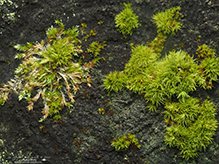 |
||
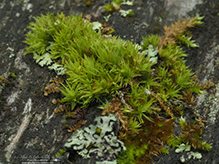 |
|
|
Luciearl |
||
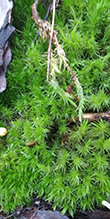 |
||
MinnesotaSeasons.com Photos |
||
|
||
|

Slideshows |
|

Visitor Videos |
||
Share your video of this plant. |
||
This button not working for you? |
||
|
Other Videos |
||
Dicranum scoparium Natural forest trees, bird sounds, relax |
About
Mar 21, 2020 Dicranum scoparium Natural forest trees, bird sounds, relax |

Created: 10/14/2023 Last Updated: © MinnesotaSeasons.com. All rights reserved. |

